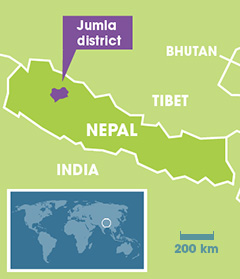By: Shahani Singh
Send to a friend
The details you provide on this page will not be used to send unsolicited email, and will not be sold to a 3rd party. See privacy policy.

When the indigenous ‘Jumli Marsi’ variety of rice, grown in Nepal’s Jumla district, was hit by blast infection, farmers had little choice but to substitute it with the Chandannath 1 and 3 'improved' varieties developed through hybridisation and originating in China.
The Chandannath varieties stood up well against Magnaporthe grisea, the blast fungus, and the farmers were happy. But, it was not long before farmers and consumers realised that Jumli Marsi made for a more satisfying meal.
“We took a perception survey and found that people prefer to eat Marsi. There is some truth to it – perhaps the nutrition value is high in Marsi,” says Bal Krishna Joshi, senior scientist and plant breeder at the National Agriculture Genetic Resources Centre (Genebank) in Kathmandu. “Marsi soaks up milk and ghee and becomes sweet,” he adds.
Scientists at the ‘Integrating Traditional Crop Genetic Diversity for Mountain Food Security Project’ are currently conducting research on policy gaps for agriculture biodiversity and looking at developing a varietal blend of Jumli Marsi and Chandannath 1.
But, there are difficulties. “At the policy level, there are no provisions for mixing. We have yet to debate whether in order to register a varietal blend, we ought to register the blend, the parent varieties, or register the technology. We need to create a provision for it,” says Joshi.
With policy gaps that hinder innovation and marginalise indigenous seeds, Nepal’s experts are calling for a new approach. And seed farmers like Bishnu Bahadur Rawal are looking for assurance on farmers’ basic rights and an informed agriculture policy.“We heard about an agriculture policy three years ago over radio, but we have not seen anything on the ground yet,” Rawal says. “If a pro-active farmer like me has not seen the policy, then farmers in remote and far-flung areas are unlikely to have even heard of it.”
Rawal took up the issue at a training workshop for strengthening the seed system of local crops, held at Kathmandu’s Genebank last December. “It would be better if the policy is revised and reformed after considering inputs from farmers. Farmers do not know much about the policy — or even that there is one,” he commented at the workshop attended by farmers, researchers, seed companies and a top government representative.
“If you observe the formal seed system, there are no laws that openly support the systemisation or marketing of indigenous seeds,” Joshi said at the workshop.
Nepal’s new Agriculture Development Strategy, implemented since January 2016, addresses farmers’ rights and seed sovereignty, though it omits minor, underutilised crops. The National Agro-biodiversity Policy, revised in 2014, has a conservation focus and discusses the conservation of underutilised species.
“The government has to prioritise conservation of neglected and underutilised crops in terms of research, investment and preparation of an institutional framework that covers human resources and educational materials,” Devendra Gauchan, agriculture economist and project manager at the Nepal office of Bioversity International, tells SciDev.Net.
This story was partly supported by the. Himalayan Climate change Adaptation Programme (HICAP) for journalists implemented by ICIMOD, CICERO and GRID-Arendal and the governments of Norway and Sweden. The UNEP/GEF project "Integrating Traditional Crop Genetic Diversity for Mountain Food Security" (www.himalayancrops.org) is being jointly executed by Bioversity International, NARC, DoA and LI-BIRD in Nepal.













